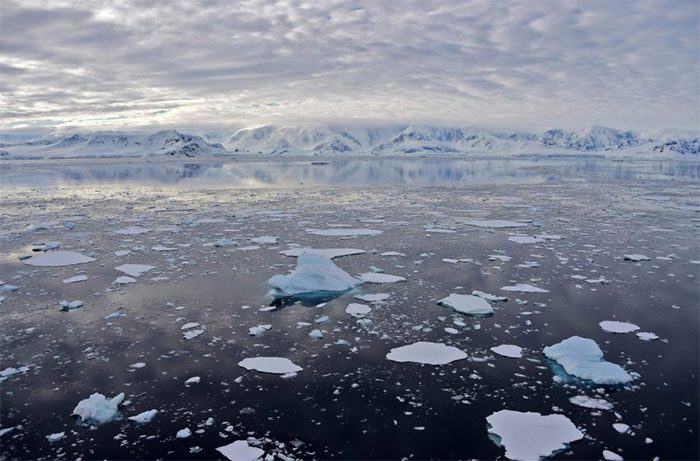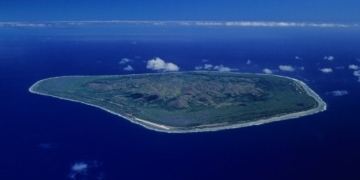While the Northern Hemisphere is grappling with record-breaking heat this summer, the Southern Hemisphere remains immersed in winter, breaking another alarming climate record.
The surface ice in Antarctica has dropped to unprecedented lows for this time of year.
Each year, by the end of February, sea ice in Antarctica shrinks to its lowest point due to the arrival of summer. Subsequently, sea ice forms again during winter. However, this year scientists have observed a notable difference.
The sea ice has not returned to nearly the expected levels. In fact, it is at its lowest for this time of year since data was first recorded 45 years ago. According to data from the National Snow and Ice Data Center (NSIDC), the ice area is approximately 1.6 million square kilometers, below the previous winter record low set in 2022.

Ice drift in Chiriguano Bay, South Shetland Islands, Antarctica. (Photo credit: AFP/TTXVN).
By mid-July, Antarctic sea ice was 2.6 million square kilometers below the average for the period of 1981-2010. This area is nearly the size of Argentina.
This phenomenon has been described by some scientists as exceptional and rare, potentially occurring only once every millions of years.
Ted Scambos, a glaciologist at the University of Colorado Boulder (USA), warns: “It makes no sense to talk about the likelihood of things occurring in the way the system used to operate. The climate system has clearly changed.”
Antarctica is a remote and complex continent. Unlike the Arctic, where sea ice consistently declines as climate crises escalate, Antarctic sea ice has fluctuated erratically between record highs and lows over the past few decades, making it more challenging for scientists to understand how this region responds to global warming.
Since 2016, scientists have begun observing a sharp downward trend.
Mr. Scambos comments: “The Antarctic ice system is always changing. However, the current level of change is so severe that some things have changed drastically in the past two years.”
Expert Scambos believes the record low sea ice this winter is a very alarming signal. “In 2016, Antarctic sea ice first saw a significant decline. Since then, it has remained low, and now the record low has been broken.”
Scientists point to several factors contributing to the loss of sea ice, including the strength of the westerly winds around Antarctica, associated with increased pollution that warms the Earth.
“Warmer ocean temperatures north of the Antarctic Ocean boundary compared to the rest of the world’s oceans are also a part of the reason for the ice loss and its inability to recover to previous levels.”
According to Mr. Scambos, this unprecedented phenomenon this winter may indicate a long-term change for this isolated continent.
“It is likely that we will not see the Antarctic ice system recover in the way it operated 15 years ago for a long time in the future. In fact, that could be ‘never,’” Mr. Scambos warns.
Meanwhile, some experts offer more cautious assessments. Julienne Stroeve, a senior scientist at the National Snow and Ice Data Center, states: “This is a significant difference from the average, but we know that Antarctic sea ice always experiences large variations from year to year. Thus, we cannot yet determine whether this phenomenon will be considered a new normal.”
Sea ice plays a crucial role in the global climate system. Although it does not directly affect sea level rise, which continuously floats in the ocean, it does have an indirect impact. The disappearance of Antarctic sea ice exposes coastal ice sheets and glaciers to waves and warm seawater, making them more susceptible to melting and calving.
The lack of sea ice could also have significant impacts on Antarctic wildlife, including the mollusks that many species of whales, penguins, and seals rely on for food.
Antarctic sea ice contributes to regulating the planet’s temperature. This means that its disappearance could cause layer effects that extend beyond the continent.
Individual areas of Antarctica have witnessed alarming changes in recent times. The Antarctic Peninsula, a sharp, icy mountain range jutting out from the west, has been recorded as one of the fastest-warming places in the Southern Hemisphere.
Last year, scientists reported that the vast Thwaites Glacier in West Antarctica – also known as the “Doomsday Glacier” – is at risk of being “on a knife’s edge” as the Earth warms. Scientists estimate that global sea levels could rise by about 3 meters if Thwaites completely collapses, devastating coastal communities worldwide.


















































